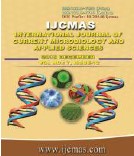


 National Academy of Agricultural Sciences (NAAS)
National Academy of Agricultural Sciences (NAAS)

|
PRINT ISSN : 2319-7692
Online ISSN : 2319-7706 Issues : 12 per year Publisher : Excellent Publishers Email : editorijcmas@gmail.com / submit@ijcmas.com Editor-in-chief: Dr.M.Prakash Index Copernicus ICV 2018: 95.39 NAAS RATING 2020: 5.38 |
Brown spot caused by (Bipolaris oryzae) is a persistent disease of Paddy (Oryza sativa L.) and associated with reduction in economic yield in the areas under dry and semi dry climate, with the nutrient poor field. Part of the paddy area under cultivation is salt affected in India, having longer water stagnation capacity, though having deficiency of organic matter and other essential nutrient, where during monsoon season only paddy is grown. In the present study twelve varieties of paddy were evaluated in salt affected soil, during nursery conditions, and was observed that variety developed for salt tolerance (CSR30. CSR 36 and CSR 46) to BS disease in all the parameter like Disease incidence (DI), Disease Index and AUDPC value whereas, these parameter were highest for scented variety (Kala Namak) having GI in Uttar Pradesh (India) have disease incidence (69.75 and 66.25%) fine grained variety Ganga Kavery with average DI of 60 % and 60.75%, were more susceptible to the disease in both year (2017 and 2018). During the observation it was depicted that both DI and AUDPC values varies according to the disease incidence. It was hypothesized that absorption of Silicon a beneficial nutrient (a major mineral element conferring resistance to the BS) and conferring Salt tolerance to the plant varieties salt tolerant varieties (CSR30, CSR36 and CSR 42) is more efficient and then the other available varieties. Further, it was also observed that in the salt affected main field, along with normal rainfall reduces disease incidence without any chemical fungicide application.
 |
 |
 |
 |
 |